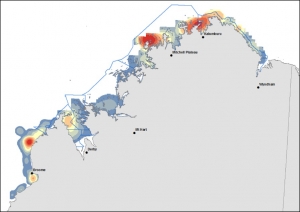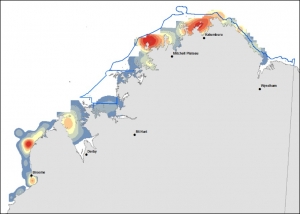Saltwater crocodile populations continue to grow in Prince Regent River

Population growth rates of estuarine (saltwater) crocodiles in the West Kimberley region of Western Australia do not appear to be slowing, with steady increases in total numbers observed, along with a more gradual increase in the number of large crocodiles (> 3m ~ 10 ft).
There has been a 259% increase in non-hatchling crocodile numbers since the last survey of the Prince Regent system in 1986, some 30 years ago.
The presence of large creek systems adjacent to the main river are allowing sub-adult crocodiles (1.5 – 2m ~ 5-7 ft) to remain near the river of their birth, rather than having to undergo migrations or increased rates of mortality from competition by larger crocodiles. This results in sub-adults making up ~ 20% of the resident crocodile population, compared to 8% in the Adelaide River in the NT, where the crocodile population is considered stable.
Lead researcher for the Western Australian Marine Science Institution’s (WAMSI) saltwater crocodile project, Dr Andy Halford (Parks and Wildlife), when comparing the crocodile recovery in the Kimberley with that in the Northern Territory (NT) said: “Continuous research and surveys in the Northern Territory since the 1980s showed the NT population was considered to have recovered from hunting (outlawed in 1971) by 2000 and we would expect a similar pattern in WA.”
However, comparison of results with established crocodile population patterns in the NT’s Adelaide River indicates that the West Kimberley crocodile populations are still recovering from the large-scale hunting that prevailed pre 1970.
“We counted a total of 5 crocodiles >3m in length in comparison with 63 counted in the Adelaide River and we estimated a biomass density of 91.4 kg/km compared with 274.02 kg/km in the Adelaide River,” Dr Halford said.
“These findings confirm the likelihood of increasing interactions between crocodiles and humans.
 |
“The interesting difference is that, while a lot of crocodiles between (1.5-2m ~ 5-7 ft) long are usually eaten or killed by larger crocodiles or forced to move into new territory, the percentage of young adults entering the West Kimberley system is up to three times that seen in the NT,” he explained.
 |
“What this study has told us is that while crocodile populations are healthy and recovering well, because of the unique environment and the considerably smaller amount of appropriate nesting habitats in the West Kimberley, exactly how the future recovery will pan out is unclear.
“What we do know is that there will be increased interactions between crocodiles and humans, and in order to provide advice on managing this, we need to learn more about the amount of available nesting habitat throughout the region, as well as updating our surveys of other river systems,” Dr Halford said.
Dr Halford’s full presentation is available on the WAMSI saltwater crocodile project webpage
The $30 million Kimberley Marine Research Program is funded through major investment supported by $12 million from the Western Australian government’s Kimberley Science and Conservation Strategy co-invested by the WAMSI partners and supported by the Traditional Owners of the Kimberley.



%20and%20Wayne%20(centre%20left)%2C%20assist%20with%20photo-identification%20alongside%20researcher%20Simon%20Allen%20(right)%20and%20skipper%20Andy%20Yardley%20(cen.JPG)























